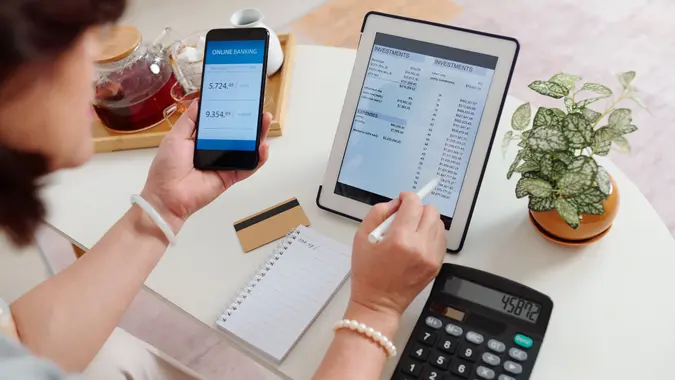I’m an Economist: Why Trump’s Tariffs Keep Changing & How They Impact Your Money

Commitment to Our Readers
GOBankingRates' editorial team is committed to bringing you unbiased reviews and information. We use data-driven methodologies to evaluate financial products and services - our reviews and ratings are not influenced by advertisers. You can read more about our editorial guidelines and our products and services review methodology.

20 Years
Helping You Live Richer

Reviewed
by Experts

Trusted by
Millions of Readers
It may seem like just about every day in the United States, there’s news from President Trump’s administration about tariffs, deals, trade wars and a questionable economic plan. Trump has said that these higher tariffs on other countries and trading partners alike are needed to help the working Americans’ pockets.
However, it can be confusing to understand how those tariffs actually impact everyday American consumers through price increases, labor market shortages and the overall global economy. To help, Noah Yosif, chief economist at the American Staffing Association, shared his analysis of what’s happening and what it means for many Americans.
Quick Take: The Current Effect of Trump’s Tariffs
There has been a lot of back and forth about the impact of tariff mandates in both the short term and long term, but ultimately, it comes down to how and why they are changing, and what that means for your money. Here are some examples:
- The National Association of Home Builders (NAHB) estimated that before the recent 50% tariffs on steel and aluminum added roughly $10,900 to the average cost of a new home. This could also reduce the number of homes being built, which would create a housing shortage and lead to higher inflation pricing thanks to warped supply and demand.
- Some economists predict that Trump’s tariffs are expected to drive up auto costs anywhere between $4,000 to $12,500, depending on what type of car you buy and where it comes from. For example, there is an imposed 25% tariff on steel and aluminum that could hurt U.S. automakers on imports from Mexico and Canada.
- Here are some tariffs you’ll encounter on everyday items in your cart: Coffee from Brazil (tariff rate: 10%) and Colombia (tariff rate: 10%); olive oil from anywhere in the European Union (tariff rate: 20%); seafood from Chile (tariff rate: 10%), India (tariff rate: 26%), Indonesia (tariff rate: 32%) and Vietnam (tariff rate: 46%); fruit from Guatemala (tariff rate: 10%), Costa Rica (tariff rate: 10%) and Peru (tariff rate: 10%).
Why So Many Changes?
You may be wondering why the tariffs have been changing so often. According to Yosif, a former economist with the Bureau of Labor Statistics, and Toby Malara, vice president of government relations at the American Staffing Association, one big reason is that the tariffs involve many different parties.
“We’re witnessing real-time, public negotiations between the Trump administration and other governments,” Malara said. “The types of adjustments and policy movements we’re seeing are the results of fluid discussions and deals happening with countries throughout the world.”
How Will Tariffs Impact Consumers?
To put it simply, Yosif said the jury is still out on whether the economy will be able to absorb the potential shock from tariffs, resulting in everything from higher prices to trade deficits.
“Tariffs are a financial penalty on businesses, usually transferred onto consumers, for buying products from abroad,” Yosif said. “Consumers will feel the pinch when they buy everyday products subject to the tariffs, and after the Fed raises interest rates to quell the consequent rise in inflation.”
Meanwhile, per Yosif, the fervent frontloading of imported goods by businesses last quarter has spared consumers from larger markups until later in the year.
“With tariffs largely affecting intermediate purchases incorporated within domestically produced goods, consumers are likely to see a gradual uptick in prices as businesses adjust their supply chains to the new realities of global trade policy,” Yosif said.
Caitlyn Moorhead contributed to the reporting for this article.
Editor’s note on political coverage: GOBankingRates is nonpartisan and strives to cover all aspects of the economy objectively and present balanced reports on politically focused finance stories. You can find more coverage of this topic on GOBankingRates.com.
More From GOBankingRates
 Written by
Written by  Edited by
Edited by 

























